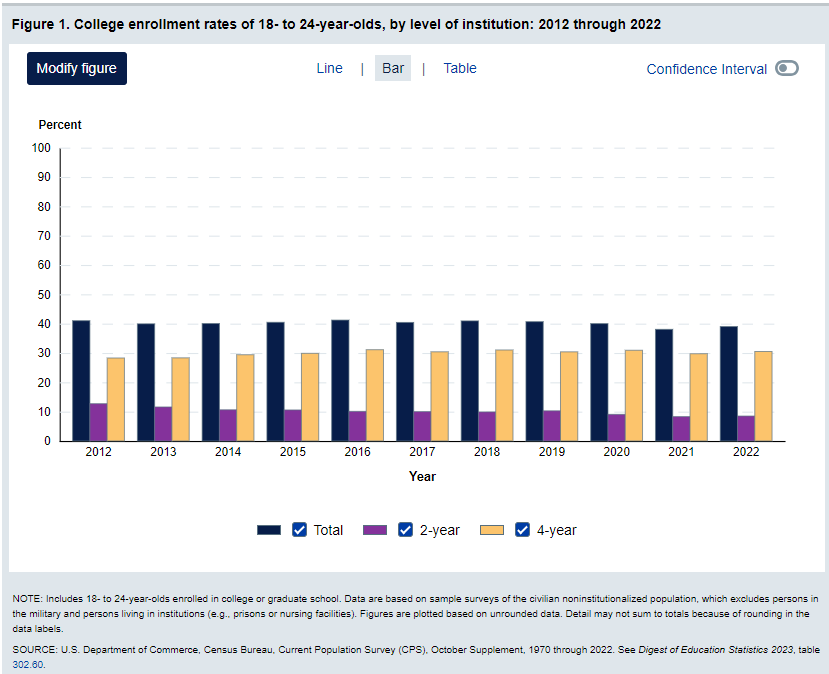The advancement of technology in the higher education landscape has paved the way for student-centered learning. The latest technology is only getting better! The difference in quality of education we receive now versus 25 years ago is mind-boggling, so let’s give special thanks to technology. Even looking back at the past 10 years, we’ll see a significant difference in the role technology plays in higher education. Students used to have to check out a book in the library on certain topics to do research for classes. Now, you can type away on your phone or computer while your professor is speaking and get more information in real-time. As the years go on, the technological trends in higher education will only get more helpful and advanced. Let’s take a look at these emerging technology trends together!
Artificial Intelligence
To offload certain tasks, technology can be trained with algorithms to help with administrative things throughout college and even while you’re learning. Artificial intelligence (AI) can be used to help professors, advisors, admission committees, and even students. These machines and computer systems can work like humans once they’ve been computed and programmed to do tasks.
Testing and online assessments are a huge part of the college experience. Professors can use artificial intelligence-driven algorithms to help grade tests and provide personalized feedback to help with student progress. Instead of waiting weeks for your 200-person lecture hall course to release grades, AI technology will have results much quicker. Artificial intelligence will also help eliminate bias so everything is graded fairly.
The admissions committee can use AI to comb through likely prospective students and categorize them based on certain qualities in their college application. The algorithm can be programmed to look at students’ interests, performance, and other data. While actual humans should still go through the applications to pick their future students, categorizing the applicants will help with financial aid rewards, enrollment periods, and more. Colleges like UT Austin have used this system to go through applicants recently and have found that it helps them decrease the amount of time it takes to look through admissions.
Students will be able to use artificial intelligence to access knowledge quicker than before. They’ll no longer have to raise their hand every time they have a question in class and wait for the professor to call on them. Students can use AI to answer those questions in a matter of seconds.
Click here for top schools with AI bachelor’s degree programs.
Online Learning
With the opportunity to get a college degree online, people of all backgrounds and professional levels can pursue higher education. Online courses and distance learning are the latest trends that have opened doors for many students. They’ve allowed students to continue working while studying. There is no longer a need to drive to college and be there all day to complete a degree!
When taking online classes, students are able to maintain full-time and part-time jobs to advance their careers, take care of their families, and maintain a flexible schedule. Especially within the last few years, we have seen platforms for online education become more user-friendly and helpful.
Online education also goes beyond the virtual walls of a college now. With resources like YouTube, Khan Academy, and other digital platforms, you can learn about endless topics with educational videos. Video-assisted learning is easy to follow and one of the latest educational trends for students. There is no end to the online space for education. It allows anyone with online access to become a student of some sort.
Virtual Reality
You may have heard of virtual reality, but probably not in the space of higher education. Usually, you’ll see these current trends in the gaming industry with virtual reality goggles. Its advancement within the last few years has allowed it to make its way into the education sector. Virtual reality is an immersive experience. This means it is allowing you to see things you may not have been able to see before! You can visit mountains, see the moon, and even witness educational phenomena. This current tech trend in higher education will be something you’ll see more of in the upcoming years.
The interactive technology of virtual reality will allow medical students to observe a variety of topics. Observation in great detail will change the future of medicine. Students will also have the opportunity to see historical sites and visit outer space. All thanks to this huge advancement in technology. Taking a deeper dive into these different spaces gives students opportunities that have never existed before in virtual reality.
Higher Education Technology Trends: Summary
AI, online learning, and virtual reality are becoming more prevalent technology trends in higher education. It is important to note that learning from professors and other humans is still crucial. Technology can’t portray empathy and emotions the way humans can. Technology is developed by humans so no matter how advanced it gets, it will have some flaws. A decade from now, we will see how these technological trends will affect the next generation of students.





